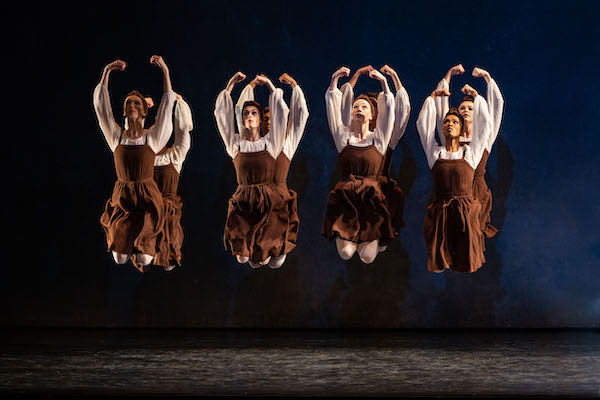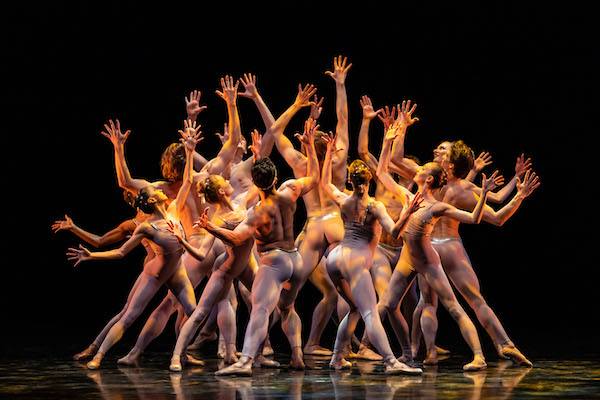Ballet West closes season with a bracing blast of classic modernism
The final Ballet West production of the season finds the company tucking away grandiose Romantic narratives for three short, exploratory works. In these less-often-seen works from some of the most notable artists of the 20th century, Ballet West showcased the strength and skills of their dancers Friday night in a style of dance as much informed by ballet as it is modern choreography, folk dance and he avant garde.
The main work of the evening was Les Noces (The Marriage), which gives the program its title. The arresting music by Igor Stravinsky is scored for a percussion arsenal, four pianos and full choir, directed here by Jared Oaks (orchestra) and Aubrey Woods (choir).
Les Noces is a unique entry in the five Ballets Russes collaborations between the famed composer and artistic director Sergei Diaghilev. The piece is austere and bleak, cast in four short movements detailing an impending arranged marriage between a woman (Victoria Vassos) and a man (Dominic Ballard) from different Russian villages. The entire ensemble was dressed in boxy brown rags, dancing against blurry, beige approximations of a house interior in stoic, somber movements.
The piece’s understated choreography mirrors this visual design, and Vassos and Ballard meet the work with muted performances. Instead of flourishing their expressivity, they excel in more subtle instances—the deadpan glare they hold throughout, the dreaded, affectionless tone they hold in the wedding ceremony, that scene itself already obscured behind the mass of ensemble dancers. Though less obvious a display than the succeeding numbers, the lead pair show the difficult-to-attain power of restraint in movement.
More than the stars, this ensemble emphasizes the force and personality of Bronislava Nijinska’s’s choreography. The dancers move in rigid, rote synchronicity, their individualistic identities melting away into sweeping masses of fabric and bodies. Particularly notable are the village-wide group numbers in the finale, which find the men and women facing off on each side of the stage with movements alternately clunking and delicate.
The tower of side-stacked heads that adorns the program cover is a tame preview of the live sculptures created throughout the piece. Using the bride’s meters-long braids as a mock maypole, the ensemble women form shapes like Rorschach blots and suffuse the piece with a nameless melancholy further accented y Stravinsky’s dissonant music—the lament of a woman lost to a formalistic marriage delivered through requiems and effigies.
Light Rain from choreographer Gerald Arpino, too is also an atypical work. Arpino sets his piece to a riveting score by Douglas Adamz and Russ Gauthier that combines the rhythms, instrumentation and melodic structures of a variety of Eastern European and West Asian traditions—most recognizably Persian and Romani music—into a grooving pastiche. The dance takes a similarly postmodern lens, sifting folk textures and classical ballet through a filter of modern dance. In the opening and closing movements, small groups of dancers enter and exit the stage in chaotic cohesion. The total effect is mesmerizing as the cluttered space rapidly draws the eye from a leaping soloist to a twirling quartet to a pair of suave, slithering dancers.
The spectacle of the night was Light Rain’s pas de deux, performed on opening night by principal artists Emily Adams and Hadriel Diniz. The dance emphasizes strained, arduous movements and held contortions that look like verticalized Twister poses. Adams and Diniz move together like rusted cogs of a gear before engaging in moments of high drama, from bounding leaps and rolls to Diniz sweeping Adams around the floor while she maintains the splits. Alongside the rapturous, beat-driven music, this number offered a key moment where the program’s left-of-center nature met technical fascination.
The night’s centerpiece, Jerome Robbins’ In the Night, displayed more traditionalist choreography, a palate cleanser between the highly individual bookends. Across three duets and one final group number—set to some of Chopin’s most famous Nocturnes, performed fluidly by Nicholas Maughan—six dancers explore the effects of movement and body language on romance. Amy Potter and Diniz open the piece as a newly acquainted couple performing birdlike courtship dances across the stage from each other. The repeated hesitancy of their movements—almost just touching before falling away—visualizes the yearn of early romance against the piece’s simple, nostalgic background of a night sky.
Emily Adams and Adrian Fry countered the freshness of the opening pair with a more lived-in connection. Their dance relies on slow, synchronous movements and a steady approach to co-dependent movement—Fry frequently leans into a supportive role, grounding Adams as she extends and alights.
The final couple, Katlyn Addison and Brian Waldrep, emerged as a quarreling couple with an immediate, hot-headed energy. They stumble, frequently miss each other’s cues and dance with different rhythms and destination points. At regular junctures, the pair rebound off each other and prance offstage in a tiff. In the Night progresses from a careful to a caring to a careless display of love; what it lacks in the uniqueness of Les Noces and Light Rain it accounts for in simple techniques and metaphoric complexity.
Les Noces continues through April 22 at the Capitol Theater. Previous Ballet West stars Beckanne Sisk and Chase O’Connell will perform April 20 and 22. balletwest.org.


